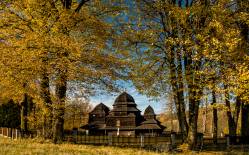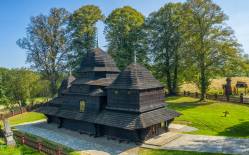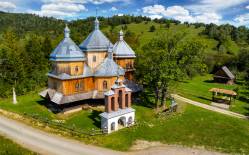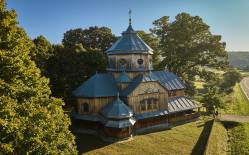The former Greek-Catholic tserkva of the Protection of Our Most Holy Lady was built in the 1700s. It is believed to have held the benevolent icon of the Holy Mother and the Child with the Prophets, which in a miraculous way survived the fire of the tserkva in Smolnik caused by Tatars in 1674.
Until 1951 the village, as well as the nearby area, were on the Soviet side of the border. After the people living here were relocated eastward, the church was used as an agricultural storehouse, and then it was abandoned. Several years later conservation works were initiated, and then in the 1960s the building was restored. The furnishings were moved to the Castle Museum in Łańcut. In 1972 Roman Catholics officially acquired the building for their rites. Today it is the filial Roman Catholic church of Our Lady of Prompt Succour.
The tserkva in Równia is a log structure, with outer walls partly covered with shingles. The church, oriented eastward, comprises a two-story pritvor, and the nave with an octagonal dome supported on an octagonal, two-tier drum. All the three parts are covered with separate domes, clad with shingles. Over the pritvor there is a clearly distinguishable chamber - also called the upper women’s gallery. Structures of this type, prior to the Synod of Zamość were used in tserkvas as chapels and held separate iconostases. Lining the whole building, a broad skirt roof is supported on log tails. The 18th century doors with fittings and hinges were replaced with new ones during restoration works. Currently they are on display in the tserkva in Bystre, along with the original stairs from this church, made from a single piece of wood.
Next to the tserkva there is a small belfry, and the old cemetery with a few tombstones. The parish cemetery can be seen to the north of the tserkva.
Photo: Krystian Kłysewicz, Marek Maciejewski
Gallery


Recommended venues on the Trail



This website has been modernized with the financial support of the European Union under the Cross-Border Cooperation Programme Poland-Belarus-Ukraine 2014-2020. The responsibility for its content lies solely with the Podkarpackie Regional Tourism Board and cannot, in any case, be treated as a reflection of the position of the European Union, the Managing Authority, or the Joint Technical Secretariat of the Cross-Border Cooperation Programme Poland-Belarus-Ukraine 2014-2020.













